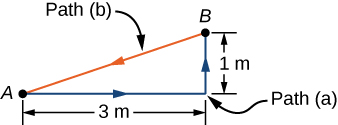| << Chapter < Page | Chapter >> Page > |
When you mow the grass, other forces act on the lawn mower besides the force you exert—namely, the contact force of the ground and the gravitational force of Earth. Let’s consider the work done by these forces in general. For an object moving on a surface, the displacement is tangent to the surface. The part of the contact force on the object that is perpendicular to the surface is the normal force Since the cosine of the angle between the normal and the tangent to a surface is zero, we have
The normal force never does work under these circumstances. (Note that if the displacement did have a relative component perpendicular to the surface, the object would either leave the surface or break through it, and there would no longer be any normal contact force. However, if the object is more than a particle, and has an internal structure, the normal contact force can do work on it, for example, by displacing it or deforming its shape. This will be mentioned in the next chapter.)
The part of the contact force on the object that is parallel to the surface is friction, For this object sliding along the surface, kinetic friction is opposite to relative to the surface, so the work done by kinetic friction is negative. If the magnitude of is constant (as it would be if all the other forces on the object were constant), then the work done by friction is
where is the path length on the surface. (Note that, especially if the work done by a force is negative, people may refer to the work done against this force, where . The work done against a force may also be viewed as the work required to overcome this force, as in “How much work is required to overcome…?”) The force of static friction, however, can do positive or negative work. When you walk, the force of static friction exerted by the ground on your back foot accelerates you for part of each step. If you’re slowing down, the force of the ground on your front foot decelerates you. If you’re driving your car at the speed limit on a straight, level stretch of highway, the negative work done by kinetic friction of air resistance is balanced by the positive work done by the static friction of the road on the drive wheels. You can pull the rug out from under an object in such a way that it slides backward relative to the rug, but forward relative to the floor. In this case, kinetic friction exerted by the rug on the object could be in the same direction as the displacement of the object, relative to the floor, and do positive work. The bottom line is that you need to analyze each particular case to determine the work done by the forces, whether positive, negative or zero.


Notification Switch
Would you like to follow the 'University physics volume 1' conversation and receive update notifications?